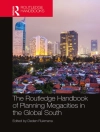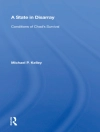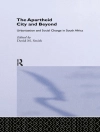This book discusses a range of planning and management issues related to building urban resiliency. It covers such topics as urban, environmental, and transportation planning, historical preservation, emergency relief and management, geographic information systems (GIS) and other technological applications. The book includes case studies of several cities and districts in China, including Shanghai, and a number of cities in the United States of America.
Urban resiliency in the face of uncertainty is a priority for planning and governance in communities worldwide. In China, which has suffered many of the world’s most devastating floods, earthquakes, and typhoons, preparing for the threat of disaster has long been an important planning objective. Recent calamities, such as the 2008 Winter Storms, the 2008 Wenchuan Earthquake, and the 2012 Beijing Floods have only made planning for resiliency more urgent. As planners work to prepare for such events, interdisciplinary collaboration becomes increasingly important. Planners need the tools and insights offered by other fields, including both the natural and social sciences. At the same time, these interdisciplinary relationships help shape the identity of urban-rural planning in its new role as one of China’s primary academic disciplines. Thus, the nexus between planning and science is critically important in building resilient cities in China, and the Chinese planning experience can serve as an example to and benefit countries around the world.
Mục lục
Chapter 1: Empirical Research on Global Value Chain and Industrial Structure Upgrading of Shanghai Putuo District; Bian Huixia.- Chapter 2: Spatial and Social Assessment of Chinese Urban Neighborhoods undergoing Change: A Case Study of a Large Scale Resettlement Neighborhood in South Jiangsu Province; Ying Chang, Jing Lu and Xiaonan Zhang.- Chapter 3: The Unprecedented Age Wave and Challenged Fixed-Route and Specialized Transportation Services: The Case of Richmond, Virginia; Xueming Chen.- Chapter 4: Resilient Planning Frame for Building Resilient Cities; Zhiduan Chen and Baoxing Qiu.- Chapter 5: Analysis on the Impact of Shanghai Human Resource Structural Changes on the Tourism Enterprises; Gong Wei.- Chapter 6: The Construction of the Neighborhood Unit System of Flood Control and Drainage Based on Landscape Infrastructure; Guan Shaoping and Zhang Xi.- Chapter 7: Community Life Regression under the Background of Rapid Urbanization; Guo Liang and Li Min.- Chapter 8: Addressing Social Revitalization in Conservation of Historic Quarters in China: A Social Capital Initiated Urban Conservation Approach; Han Jie, Wang Liangliang and Heng Chyekiang.- Chapter 9: The Strategies Research of Open Space Planning under the Goal of Building Resilient City; Yuwei Hu Jianyun Huang.- Chapter 10: A People’s Atlas of Muncie: Citizen Representations of Urban Space; Junfeng Jiao, Steven M. Radil , Jenna Harbin and Yuan Li.- Chapter 11: The Ecological Impact of the Korean Saemaul (New Rural Community) Movement, 1970-1979; Chung Ho Kim.- Chapter 12: The Analysis of Two Increases and Two Reductions Policy of Shanghai; Liao Yu-qing and Huang Jian-yun.- Chapter 13: Facade Renovation and Utilizing Ways in the Historical Commercial Streets: Rigid Planning at the Compound Level Needed in Pingyao Ancient City in China; Chenchen Li, Jie Yin and Yang Lei.- Chapter 14: Method Exploration of Sensitive Public Space System Planning in Urban Newly Areas on the Viewpoint of Systematology: A Case Study of Urban Design of Bali Lake District in Jiujiang City, Jiangxi, China; Mengchen Li and Ying Lin.- Chapter 15: Analysis of Framework and Optimization of the Urban Natural Landscape System (UNLS): Case Research of Eco-efficiency of UNLS in Tianjin, China; Pengbo Li, Jun Wu, Yan Jiang and Lei Meng.- Chapter 16: Study on the Indicator System of Eco-regional Development Planning for Shanghai Chongming Island; Liu Mingxing, Zeng Gang.- Chapter 17: A New Thinking of the Urbanization Route in Forest Ecological Function Regions: The Case of Shen-Nongjia; Liu Yun, Chang Lili and Liu Ying.- Chapter 18: Quantitative Study of Housing Price based on Huff Model and Hedonic Method; Yuan Li, Lang He, Junfeng Jiao and Guoqiang Shen.- Chapter 19: Develop A GIS Based Risk Model to Evaluate the Economic Resilience of Houston Neighborhoods for the Next Oil Bust; Pan Qisheng and Zhai Dong.- Chapter 20: Storm Preparedness: A Case Study of Delaware County, Indiana; Timothy R. Phelps, Junfeng Jiao and Yuan Li.- Chapter 21: Research on the Quality and Level of Urbanization in the Baoshan District, Shanghai; Shan Shuang.- Chapter 22: The “Policy-projects Districts” Model of New Urban Area Development in China and Its Analysis; Wang Jin-Bai.- Chapter 23: A Study on Transportation Space Improvement and Adaptation in Old Downtown Area of Middle and Small Size Cities: A Case Study for Changxing County, Huzhou; Wen Jie and Huang Jianyun.- Chapter 24: Constructure and Update of Point of Interest (POI) in Urban Open Space: A Case Study of Assessment and Reform of POI in Water Park Tianjin, China; Jun Wu, Naiwen An, Pengbo Li and Min Zhang.- Chapter 25: Comparison of Two Approaches for Evacuation Plan with Multiple Exits; Xie Jun, Wan Qing, Zhang Chi and Li Xiang.- Chapter 26: Study of Urban Patterns Optimization Employing CFD Method: A Case Study of Chenjiazhen Experimental Ecological Community, Chongming, Shanghai; Chao Liu, Peng Xu, Weizhen Chen, Liang Zhang and Weilin Li.- Chapter 27: Assessing Public-Sector Transportation Finance and Planning in Urban China; Jiawen Yang and Chuanglin Fang.- Chapter 28: Rational Traffic Dispersion: Take the Example of No Left Turn in the Rush Hours along Renmin Road in Suzhou City; Yao Yangyang.- Chapter 29: Problems and Redevelopment Strategy for Old Industrial Area: After an Accident in Nanjing’s Mai-Gao-Qiao Area; Xin Yi.- Chapter 30: Analysis of the Planning Mode of Resilient Urban Space Structure; Zhou Min, Lin Kaixuan and Huang Yaping.- Chapter 31: The Impact of Building Control on Urban Planning and Building Management in Hong Kong; Han Zou and Charlie Q.L.Xue.
Giới thiệu về tác giả
Xueming Chen received his Ph.D degree in urban and regional planning from University of Southern California. He is currently serving as the associate professor of urban and regional planning program, L. Douglas Wilder School of Government and Public Affairs at Virginia Commonwealth University. His research interests include transportation planning, transportation modeling, and geographic information systems. He was the Chair of Board of Directors, International Association for China Planning (IACP) from 2011 to 2013.
Qisheng Pan is a Professor and Chair in the Department of Urban Planning and Environmental Policy at Texas Southern University. Dr. Pan received a Ph.D. in Urban Planning from the University of Southern California (USC) in 2003 and a Master’s degree in Computer Science from USC in 2001. He also held a Master’s degree in Cartography and Remote Sensing and a BS in Geology from Peking University. Dr. Pan’s research focuses on multiple aspects of urban planning, including transportation planning, economic impact analysis, and the applications of GIS in urban planning. He has received research grants from Texas Department of Transportation (TXDOT) to measure access to public transit services and to examine port-related traffic and emissions. He has also studied on the economic impacts of terrorist attacks on Central Business Districts and infrastructures in large metropolitan areas. Recently he received the Natural Resources Imagery Grant from ESRI to utilize SAR imagery technology in pipeline integrity management. Dr. Pan has consulted in multiple research projects from National Science Foundation’s Digital Government Program and Department of Homeland Security. Dr. Pan is serving as the Chair of the Board of Directors (BOD) for the International Association for China Planning (IACP), 2013-2015.












